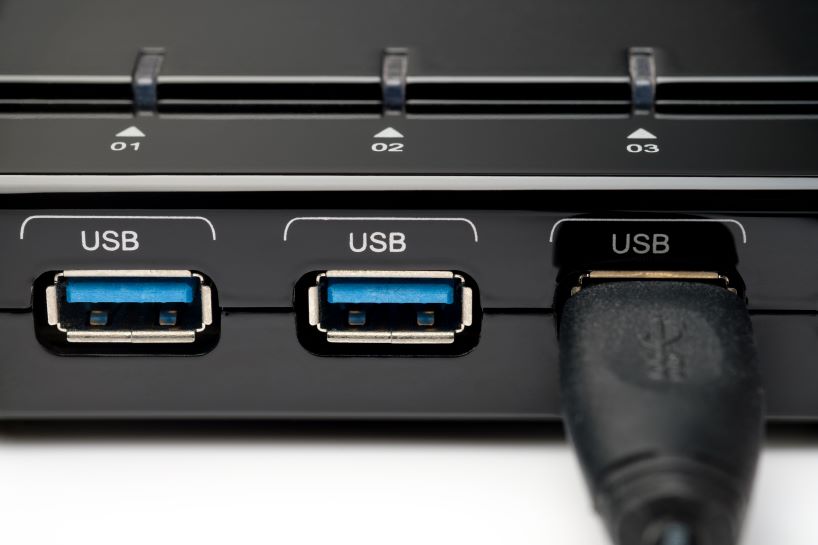USB 2.0 and USB 3.0 are two notable USB data transmission technologies. Understanding the differences between USB 2.0 and USB 3.0 is essential for optimizing data transmission speeds since we use USB ports to connect many devices. In this complete guide, we’ll compare these two USB types and explain how to distinguish them.
USB Generations Overview:
1. USB 2.0 – The Standard of the Past:
USB 2.0, introduced in the early 2000s, became the standard for connecting various peripherals and devices. With a maximum data transfer rate of 480 Mbps (megabits per second), it significantly improved upon its predecessor, USB 1.1, offering faster and more efficient data exchange.
2. USB 3.0 – Paving the Fast Lane:
USB 3.0, released later in the same decade, marked a substantial leap in data transfer capabilities. Boasting a maximum transfer rate of 5 Gbps (gigabits per second), USB 3.0 introduced a new level of speed, making it ideal for handling large files and facilitating faster charging for compatible devices.
Identifying USB Versions:
3. Connector Color Distinction:
One of the easiest ways to distinguish between USB 2.0 and USB 3.0 is by examining the connector color. USB 2.0 connectors are typically black or white, while USB 3.0 connectors are often blue. This color-coding simplifies the identification process and helps users recognize the version at a glance.
4. Inside the Connector:
If color isn’t immediately apparent, examining the inside of the USB connector can provide clarity. USB 3.0 connectors have additional pins compared to USB 2.0, which enables faster data transfer. While USB 2.0 has four pins, USB 3.0 has nine, making it easy to differentiate them visually.
Data Transfer Speeds:
5. USB 2.0 – Adequate for Basic Needs:
USB 2.0, with its maximum transfer rate of 480 Mbps, is suitable for connecting peripherals like keyboards, mice, and printers. However, it might not be optimal for handling large files or supporting high-speed data requirements.
6. USB 3.0 – Speeding Ahead:
USB 3.0’s impressive maximum transfer rate of 5 Gbps positions it as the preferred choice for tasks demanding high-speed data exchange. External hard drives, high-resolution cameras, and other data-intensive devices benefit significantly from the enhanced speed capabilities of USB 3.0.

Backward Compatibility:
7. USB 3.0 – Embracing Legacy Devices:
One of the noteworthy features of USB 3.0 is its backward compatibility with USB 2.0. This means that USB 3.0 ports can seamlessly support USB 2.0 devices, allowing users to connect older peripherals without any issues.
8. USB 2.0 – Limited to Its Generation:
USB 2.0 ports, however, lack the ability to support the higher speeds of USB 3.0. While USB 3.0 devices can physically connect to USB 2.0 ports, they will operate at the lower USB 2.0 speeds.
Practical Applications:
9. USB 2.0 – Everyday Connectivity:
USB 2.0 remains prevalent in everyday devices, serving well for connecting accessories, input devices, and low-data-rate peripherals. It is still commonly found on many computers and laptops.
10. USB 3.0 – High-Performance Demands:
USB 3.0 is the go-to choice for scenarios demanding rapid data transfer, such as backing up large files, accessing external storage devices, or connecting high-resolution cameras. Its speed advantage makes it indispensable for users with data-intensive requirements.
Conclusion:
In conclusion, the choice between USB 2.0 and USB 3.0 boils down to the specific needs of the user. While USB 2.0 remains relevant for basic connectivity, USB 3.0 stands out as the high-speed solution for data-intensive tasks. The ease of identifying USB versions through color-coding and connector pin differences simplifies the selection process, ensuring users can harness the appropriate technology for their devices. As technology continues to advance, USB 3.0 establishes itself as the future-ready option, providing the fast lane for an ever-increasing demand for rapid and efficient data transfer.
FAQ’s
Q1. What is the main difference between USB 2.0 and USB 3.0?
The main difference lies in their data transfer speeds. USB 2.0 has a maximum transfer rate of 480 Mbps, while USB 3.0 boasts a significantly faster maximum transfer rate of 5 Gbps, making it ideal for high-speed data exchange.
Q2. How can I visually identify whether a USB port is USB 2.0 or USB 3.0?
One of the easiest ways is to check the color of the USB port. USB 2.0 ports are typically black or white, while USB 3.0 ports are often blue. Additionally, USB 3.0 connectors have more pins inside compared to USB 2.0, making them visually distinguishable.
Q3. Are there any visual cues on the USB connector itself to identify the version?
Yes, examining the inside of the USB connector can provide a visual cue. USB 3.0 connectors have additional pins, giving them a different internal structure compared to USB 2.0 connectors.